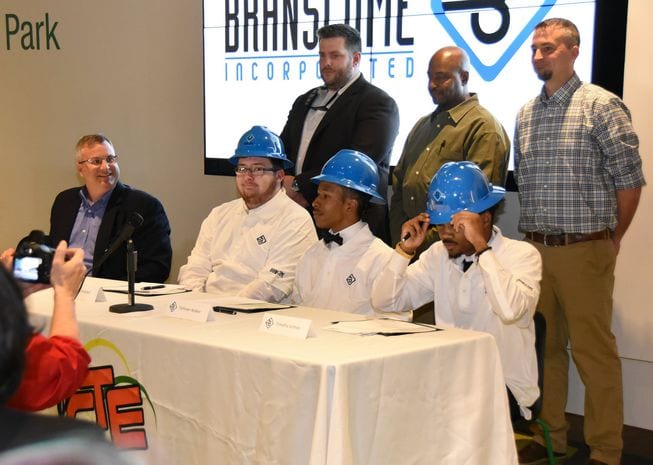
Idaho Apprenticeships Grow – But They Don’t Align with the ’60 Percent Goal
By Kevin Richert (Idaho News)
From a numbers standpoint, Idaho’s apprenticeship program is growing.
More than 1,500 students are registered apprentices, up more than 50 percent in less than two years.
More than 280 companies have a program in place — and this number has nearly tripled in less than two years.
“That’s a drop in the bucket, in terms of where we could be,” said John Russ, the apprenticeship coordinator for the Idaho Department of Labor.
But in order to grow an apprenticeship system, Idaho might also need to rethink its signature educational goal.
APPRENTICESHIPS — AND SUCCESS — DEFINED
An apprenticeship program allows students to get experience in the workplace, while taking technical classes at school.
Registered apprenticeship programs are open to students starting at age 16, which means high school students can sign up.

That’s the case in Mini-Cassia, where high school students are participating in a unique apprenticeship program with local food processing plants; and in Weiser, which has launched a fledgling apprenticeship program in heating, ventilation and air conditioning. Those are but two examples of programs in rural communities where college “go-on rates” tend to run lower than the lackluster statewide rate.
But apprenticeship programs face challenges: logistics and costs.
Mini-Cassia shoehorn its program into “zero hour,” before the start of the school day. That means early mornings for the apprentices, but school officials say the schedule is attractive to businesses and the best option for students. “We couldn’t make them choose between this class and a senior math class or an automotive class or an English class,” said Curtis Richins, director of the Cassia Regional Technical Center.
Students cannot use the state’s advanced opportunities program money for an apprenticeship course; that program only covers college-level courses. In Weiser’s case, the district is picking up the cost for the first-year College of Western Idaho HVAC courses, at $925 a pop.
Then there’s another challenge: one of perception.
A high school graduate who completes an apprenticeship and goes to work doesn’t count toward Idaho’s “60 percent goal.” The state wants 60 percent of its 25- to 34-year-olds to obtain a college degree or one-year professional certificate. Apprenticeships aren’t part of that mix — and a goal that has defined state education policy for the better part of a decade.
“We’ve kind of got ourselves into a narrow box,” Russ said.
Many educators also say the 60 percent goal gives short shrift to students who can leave high school and head straight into a good job.
“It’s definitely not a second-tier choice,” said Weiser High School Principal Dave Davies. “It’s another choice.”
BUSINESS BUY-IN
In order for an apprenticeship to become a reality, the business must be the first entity at the table, Russ said. Once a business is engaged, the Department of Labor can take the lead on developing a curriculum to match industry’s needs. “We’ve taken that burden off of them, because it can be overwhelming,” Russ said.
Federal funding has helped.
In 2016, the state received more than $1.6 million in federal grants. The state exceeded the goals it set for the first grants, so the feds followed up with another $847,000 this year. The state can use grant money to develop an apprenticeship curriculum.
The state hasn’t just tried to increase the number of apprenticeships. The state has tried to develop programs in new fields. Apprenticeships are commonplace in building trades, so the state is trying to nurture programs in computers, IT and health-related professions.
As business owners — in many sectors — deal with the impacts of a low unemployment rate, they see the apprenticeship program as a way to grow their own workers.
“Businesses are stepping up, because they know how much it’s going to help them,” Department of Labor Director Melinda Smyser said.
SHARING CURRICULUM
One potential apprenticeship success story is taking place in Boise — as two historic rivals confront a shared problem.
The St. Luke’s Health System and the Saint Alphonsus Health System have signed on for apprenticeship programs to train environmental services technicians: workers who help keep hospitals clean and dispose of hazardous materials.
For apprentices, including recent high school graduates, an EST job is a first step towards a career in health care. Apprentices can work this job while training for hard-to-fill nursing jobs.
The two large hospitals — competitors in so many other areas — are using the same model for apprenticeship programs, Russ said. That’s not uncommon. Some apprenticeship programs incorporate proprietary information, but in many cases, a curriculum can be easily shared, from business to business.
But sometimes, it’s tough to get schools to work together. It’s not necessarily a matter that schools are unwilling to share their curriculum, Russ said; instead, the schools don’t always have a vehicle to share it out.
From the beginning of the state’s apprenticeship boom, schools have been a critical partner in creating standards, Russ said. But some traditional obstacles are hard to overcome — such as a fear of change and a concern about funding.
“It’s been good, but it’s been challenging at the same time,” Russ said.



